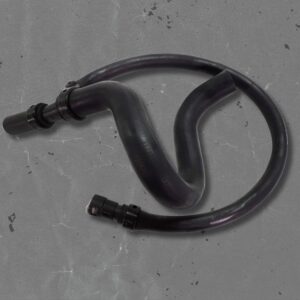Clamps secure hose connections and prevent leaks, and two of its most common types are worm gear clamps and spring hose clamps. Both keep hoses in place, but each has features that cater to different preferences and applications.
To know more about how the two differ, it’s best to first learn how they function individually.
What Are Worm Gear Clamps?
Worm-drive hose clamps or worm gear hose clamps are metal band clamps with a helical-threaded screw called the captive screw. They’re hi-torque clamps that prevent hose connections from slacking and leaking.
These clamps allow you to change their diameter by tightening or loosening the captive screw. You can then place the loose worm gear clamp around the hose, then tighten the screw to hold it in place.
What Are Spring Hose Clamps?
Spring hose clamps provide consistent pressure on the hose fittings. They have an adjustable spring mechanism that maintains tension when the hose expands and contracts because of fluctuating temperatures.
Spring clamps are made of a single strip of cut spring steel that has a tab on both ends. To use them, you’ll need to press the tabs together to enlarge the clamp’s diameter. Release the tabs after placing the clamp over the hose to secure it in place.
Difference Between Worm Gear Clamps and Spring Hose Clamps
Both spring hose and worm gear clamps hold the hose in place and prevent it from leaking. However, there are differences in how the two clamps work and last.
For one, worm clamps have a captive screw that lets you control and adjust its tightness. While you can open the pinching tabs of spring clamps, they don’t offer the same amount of control as their counterpart.
As far as preferences go, some motorists favor the spring clamps because they last longer than worm gears. They always create tension as long as the tabs are in their default state, which is a big contrast to worm gears that have screws that tend to get loose over time, causing the hose to leak.
Similarly, worm clamps have sharp edges that could cut into soft rubbers. Spring clamps are often made of spring steel, which isn’t as sharp as gear clamps.
Advantages of Worm Gear Clamps
Some advantages of worm gear clamps include their tight grip, ease of use, high clamping force, and availability/affordability.
Secure and Tight Grip
Worm gear clamps have a secure and tight grip thanks to their captive screw. This ensures you can reliably seal and prevent leaks on hoses to improve its overall performance.
Easy to Adjust
As mentioned, the captive screw gives you control over how tight you want the clamp to grip. It also makes it easier to adjust the tightness, as you’ll only need to rotate the captive screw.
High Clamping Force
Worm gear clamps also have high clamping force. This means you don’t have to worry about leaks and instability. The high clamp force ensures worm gear clamps have a strong connection with hoses or other components.
Available and Affordable
Since they’re widely used, worm gear clamps are readily available in many hardware stores. And not only are they accessible, but these clamps are relatively cheaper compared to other types. In fact, in some shops, you can buy 20 pieces of stainless clamps for under $10.
Disadvantages of Worm Gear Clamps
Worm gear clamps must be properly indexed for easy access later on. This sounds simple enough, but it’s surprising how many DIY folks and even professional mechanics don’t always think about the next person who’ll be removing the clamp.
Next, it’s not uncommon to see world gear clamps either overtightened or not tightened enough. Overtightening can damage the clamp. Under-tightening can allow leaks.
The “tongue” of a clamp that is too large may extend out from the clamp and cause issues, either with the next person working on the vehicle who has to reach past it, or, in some cases, the stiff clamp tongue may chafe against wires or other hoses and cause issues.
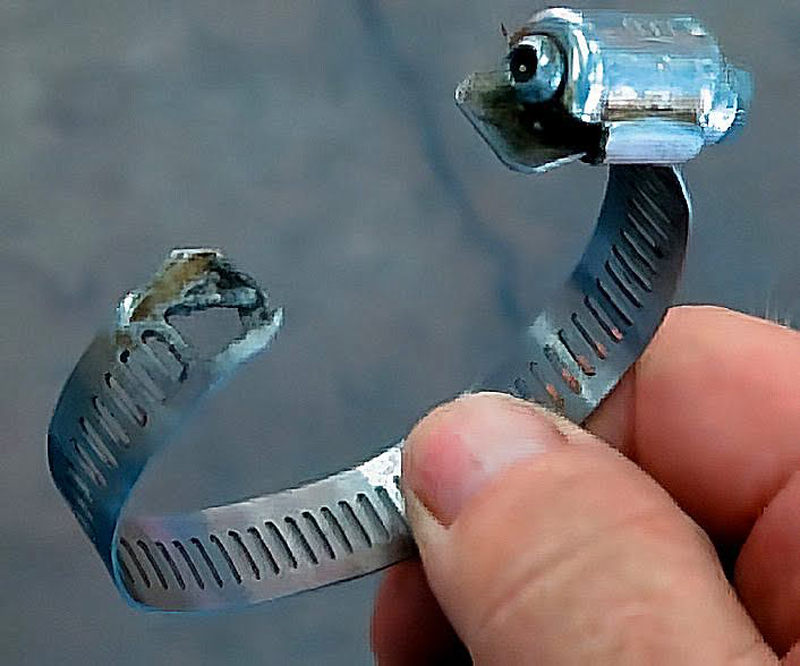
Advantages of Spring Hose Clamps
Some advantages of spring hose clamps include their constant tension, ease of use, safety, and longevity.
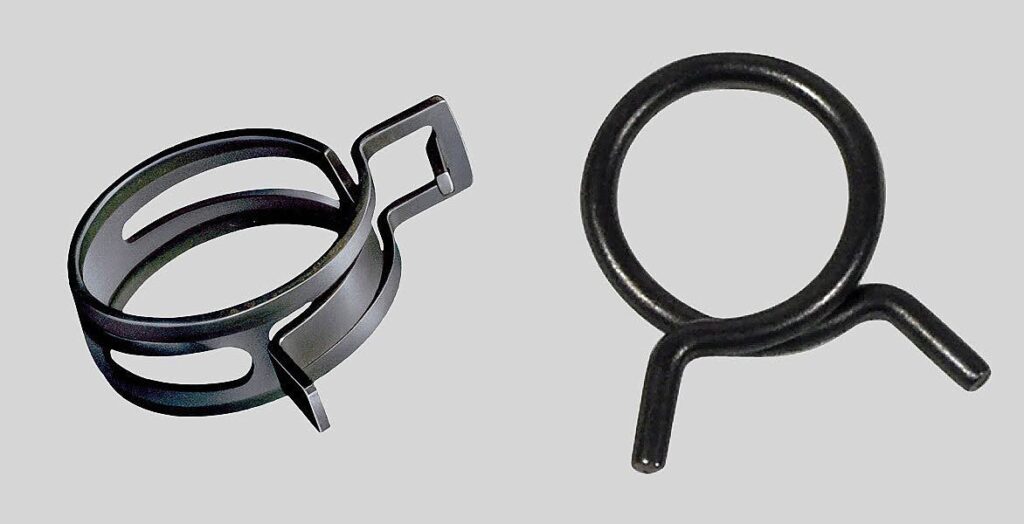
Constant Tension
Spring hose clamps provide consistent and firm tension on the hose and can maintain this pressure as long as the hose isn’t damaged. This ensures the hose is sealed and doesn’t leak. Note again that spring clamps must be just the right size for the application.
Can Be Easy to Use in Some Cases
Thanks to the spring-loaded clamping action, spring clamps can be easy to use in some cases, similar to their worm counterparts. Squeeze the handles together to loosen them and release them to apply pressure to the hose. Note that the ease of use can vary in different cases.
Safer Option
Unlike worm gear clamps, spring clamps don’t have that sharp tongue sticking out that could cut into rubber and wire harnesses. In addition, the constant tension and smooth design also minimize the risk of damaging the hose.
Longevity
Spring hose clamps stay in good condition for longer periods because they don’t have screws that tend to get loose like how worm gears do. Their durable construction means you’ll get more out of your initial purchase of spring hose clamps.
Disadvantages of Spring Clamps
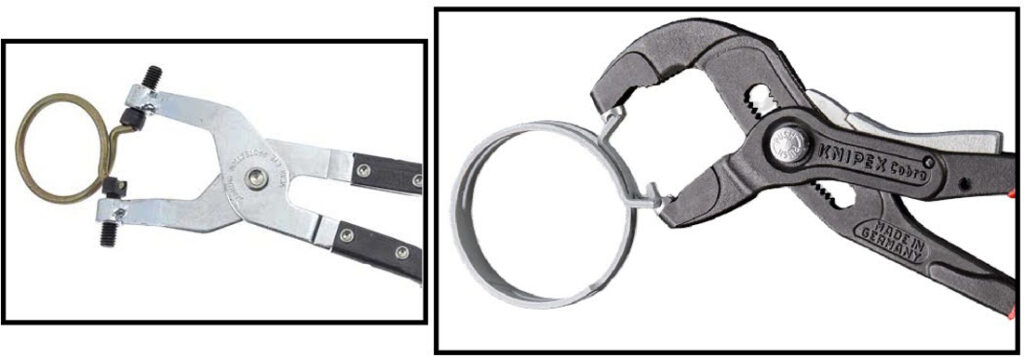
A spring clamp can be difficult to remove based on its location and indexing.
Additionally, spring clamps may require special tools, although in some cases a plain pair of pliers will work just fine. Some of the special tools will have a way of locking to hold the clamp open.
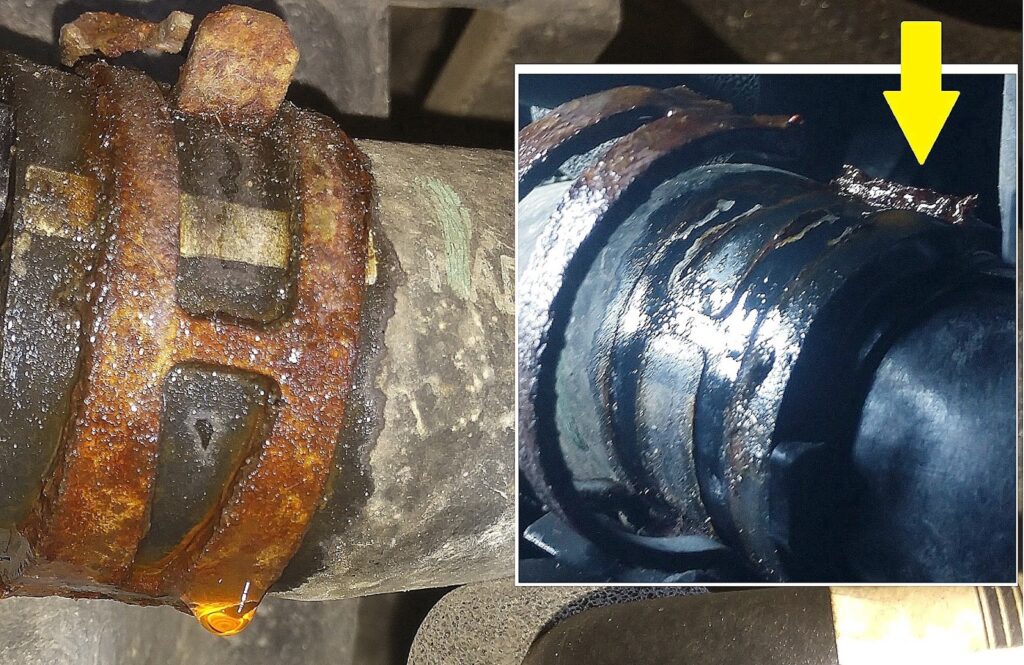
FAQs About Worm Gear Clamps and Spring Hose Clamps
Here are some of the most frequently asked questions about worm gear clamps and spring hose clamps.
Can You Over-Tighten Worm Clamps?
Yes, you can over-tighten worm clamps, which could deform the hose, reduce its flexibility, and even damage it. You can prevent this by tightening the clamp only until it forms a secure seal. However, note that you may not know if the seal is secure until the system is under pressure.
Do Worm Gear Clamps Loosen Over Time?
Worm gear clamps will naturally loosen over time because of external forces exerting tension on the screw and because of hose shrinkage. Once this happens, it won’t have a tight and secure grip on the hose, which defeats the purpose of clamps. As such, it’s important to constantly check the screw’s tightness.
How Tight Should Worm Clamps Be?
The torque of worm clamps depends on the size you’re using. Mini clamps should be around 10-15 in. lbs., while regular-sized clamps should be around 30-45 in. lbs. Of course, this differs based on application as well.
Some combinations of clamp and hose might require a higher torque. A good rule to keep in mind is that as long as the clamp isn’t damaging the hose, then it should be fine.
What Size Hose Clamp Should I Use?
To know the size of the hose clamp you should use, measure the outside diameter of the hose and select a clamp that accommodates the hose’s diameter in about the middle of its range.
There are usually hose clamp size charts online and in auto shops that you can use as reference.
Where to Get New Hose Clamps for Your Vehicle
Stay on top of those pesky leaks, and keep your daily driver performing at its best when you shop for OE-grade hose clamps here at CarParts.com.
Precision-engineered to deliver maximum durability and dependability, our selection of clamps are guaranteed to keep your hoses in check.
Find the right hose clamps for your vehicle by entering its year, make, and model into our vehicle selector. For a more personalized shopping experience, you can also use the search filters to find a hose clamp according to your preferred brand, price range, quantity, and more.
Never go over budget when you shop from us. All our products come with a low-price and lifetime replacement guarantee, helping you get the best value for your money.
Order now, and check out securely in a matter of minutes. Our fast shipping services can get the part you need delivered straight to your doorstep in as quick as two business days, so it won’t take long before you’re back on the road.
Never worry about fluid leaks again when you buy top-notch hose clamps from CarParts.com. Check out our products today, and take advantage of our unbeatable deals!
Any information provided on this Website is for informational purposes only and is not intended to replace consultation with a professional mechanic. The accuracy and timeliness of the information may change from the time of publication.















